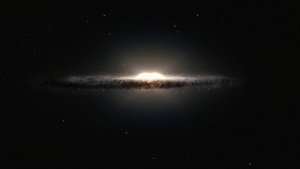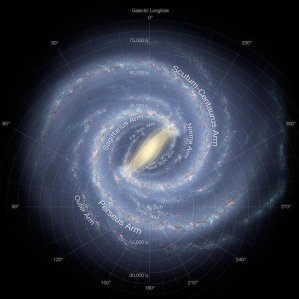

Credit: ESO/NASA//JPL-Caltech/M. Kornmesser/R. Hurt
Earlier today, two groups of astronomers released the most detailed 3D map of the Milky Way’s central bulge yet. It was created using data obtained by the VISTA telescope, located at the Paranal Observatory in Chile and the MPG/ESO 2.2-metre telescope. All of this was done to give astronomers a better view and clearer understanding of the structure of the Milky Way’s heart. The results were better than expected.
The research teams found the center of the Milky Way was shaped somewhat like e peanut (it’s also been described as an “X-shape” but, I mean, look at it. Peanut is far better). How was this map created you asked?
Firstly, astronomers from the Max Planck Institute for Extraterrestrial Physics (MPE) used the Visible and Infrared Survey Telescope’s (VISTA) Vista Variables in the Via Lactea (VVV) survey. These images, taken in infrared, this survey has been able to image stars up to thirty times fainter than previous surveys of the galactic bulge. One of the advantages of this survey was the discovery of specific type of red giant, bringing the total up to 22-million such stars orbiting the bulge. These giants are a standard candle which allows astronomers to accurately measure their distances based off their observed properties. Christopher Wegg, the lead author on this study, summarized it’s power best when he said, “The depth of the VISTA star catalogue far exceeds previous work and we can detect the entire population of these stars in all but the most highly obscured regions. This is the first time that such a map has been made without assuming a model for the bulge’s shape.”

It’s long been thought that the Milky Way was a barred spiral galaxy, part of that would mean it has an elongated nucleus. This study is the first time we’ve been able to clearly peer into the galactic bulge and study it’s shape and characteristics. The VVV survey, among others, shows the Milky Way to display characteristics seen in other barred-spiral galaxies.
Sergio Vasquez led the second study at the MPG/ESO 2.2-metre telescope. This survey, in an attempt to measure the motions of the central bulge, took two images eleven years apart. The telescope’s images are accurate enough that astronomers were able to measure slight changes in the data between the observations to determine which direction the stars were moving.
Both of these studies have joined together to make this fantastic image of the central bulge. Now, if we wait another 112-million years or so, we can image the bulge from the other side.
Quick Milky Way fun facts:

The galactic bulge contains about 10-billion stars.
The galactic bulge is about 27,000 light-years from Earth, and obscured by thick bands of dust and gas. We can only image the nucleus using longer wavelengths of light.
The Milky Way itself is thought to be about 100,000 light-years across; containing between 300 and 400 billion stars.